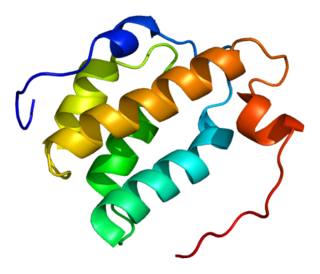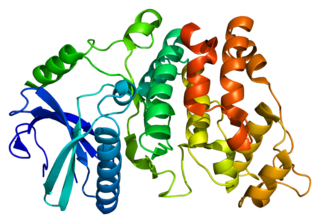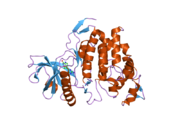
LIM domain kinase 1 is an enzyme that in humans is encoded by the LIMK1 gene.

Mitogen-activated protein kinase kinase kinase 11 is an enzyme that in humans is encoded by the MAP3K11 gene.

RAC-gamma serine/threonine-protein kinase is an enzyme that in humans is encoded by the AKT3 gene.

14-3-3 protein beta/alpha is a protein that in humans is encoded by the YWHAB gene.

Calcium/calmodulin-dependent protein kinase type II gamma chain is an enzyme that in humans is encoded by the CAMK2G gene.

Ran-binding protein 9 is a protein that in humans is encoded by the RANBP9 gene.

Serine/arginine repetitive matrix protein 1 is a protein that in humans is encoded by the SRRM1 gene.

Nuclear inhibitor of protein phosphatase 1 is an enzyme that in humans is encoded by the PPP1R8 gene.

Serine/arginine-Rich Splicing Factor (SRSF) protein kinase-1 SRPK1 is an enzyme that in humans is encoded by the SRPK1 gene.

PITSLRE serine/threonine-protein kinase CDC2L1 is an enzyme that in humans is encoded by the CDC2L1 gene.

Polo-like kinase 3 (Drosophila), also known as PLK3, is an enzyme which in humans is encoded by the PLK3 gene.

FUS-interacting serine-arginine-rich protein 1 is a protein that in humans is encoded by the SFRS13A gene.

Dual specificity protein kinase CLK2 is an enzyme that in humans is encoded by the CLK2 gene.

Serine/threonine-protein kinase MRCK alpha is an enzyme that in humans is encoded by the CDC42BPA gene.

Serine/threonine-protein kinase PRP4 homolog is an enzyme that in humans is encoded by the PRPF4B gene.

Proline-serine-threonine phosphatase-interacting protein 1 is an enzyme that in humans is encoded by the PSTPIP1 gene.

Dual specificity protein phosphatase CDC14A is an enzyme that in humans is encoded by the CDC14A gene.

Serine/threonine-protein kinase SRPK2 is an enzyme that in humans is encoded by the SRPK2 gene.

Splicing factor, arginine/serine-rich 16 is a protein that in humans is encoded by the SFRS16 gene.

Serine/arginine-rich splicing factor 1 (SRSF1) also known as alternative splicing factor 1 (ASF1), pre-mRNA-splicing factor SF2 (SF2) or ASF1/SF2 is a protein that in humans is encoded by the SRSF1 gene. ASF/SF2 is an essential sequence specific splicing factor involved in pre-mRNA splicing. SRSF1 is the gene that codes for ASF/SF2 and is found on chromosome 17. The resulting splicing factor is a protein of approximately 33 kDa. ASF/SF2 is necessary for all splicing reactions to occur, and influences splice site selection in a concentration-dependent manner, resulting in alternative splicing. In addition to being involved in the splicing process, ASF/SF2 also mediates post-splicing activities, such as mRNA nuclear export and translation.


















